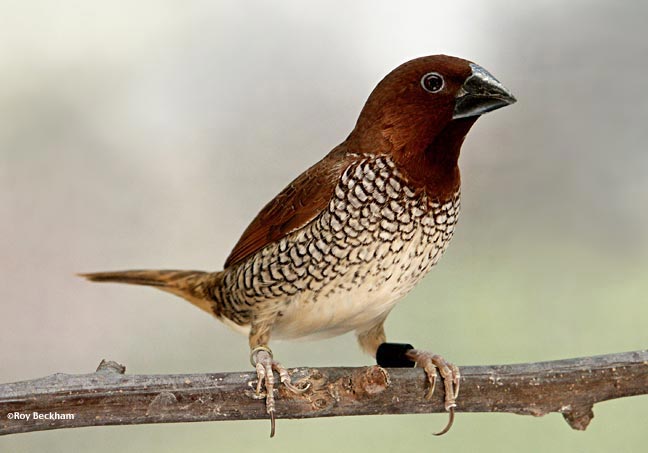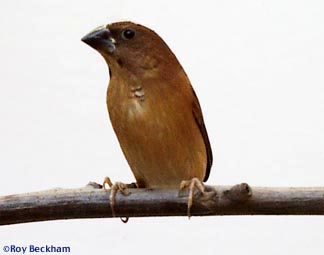|
Common Names
Nutmeg Finch, Scaly-breasted munia, spotted munia
Description
The sexes are identical with the Spice finch. The male will sing a nearly inaudible song, and stretch his neck and turn from side to side a bit when performing his courtship song. This is really the only way that I have to sex them. I have found other methods such as beak shape or the length of the "bib" in the front to determine sex to be unreliable.
Diet
The Spice finch will prefer the larger seeds of a parakeet mix to the smaller seeds commonly found in most finch mixes. The imported stock that I acquired while still in juvenile plumage, was reluctant to take any of my egg food (Roy's egg food). So I introduced Society finches that were already used to the food to teach the Spice finches what was good to eat. I usually place my egg food on top of gamebird crumbles to get them to try that as well. The Spice finches will now eat the egg food and I think they eat some of the gamebird crumbles. They will eagerly take green foods. I have never offered mine any live food. They should be given access to grit, and calcium in the form of crushed egg shells, crushed oyster shells and cuttlebone.
Breeder's Notes
The Spice finch can usually be enticed to breed and is one of the easier Mannikin/Munia to get into the nestbox (except of course the Society finch). They will take a standard finch box with either a half open or hole entrance. In this they will stuff a variety of coarse grasses and hay and line the nest with either fine grass or a few feathers. The nests constructed in my outside flights (see one with chicks) used bamboo leaves, rice hay and some feathers from the molting Mountain quail they were housed with. Coco fiber would also be used in a nest if provided. The clutches ranged from 4-8 eggs. Incubation is approximately 14 days. The dusky colored young emerge after 19-23 days and were fed the same daily diet as the parents usually received. Being as they were in a large flight mixed with other species, I did not attempt to offer them any thing different to feed their young, but they did consume more of the eggfood than usual. They are independent in 2-3 weeks after fledging.
Spice finches take approximately 7 months to reach sexual maturity and it takes them nearly all of that time to molt into their adult plumage. If you plan to colony breed these birds, which is a good idea, try to purchase those in juvenile plumage. They appear to form pair bonds during this period.
Additional Notes
There are numerous subspecies of the Spice finch. Of the over one dozen variations, the Philippine subspecies is probably the easiest to distinguish. Specimens I've seen are smaller and the scaling on the breast is not as pronounced. There is another subspecies that has shown up mixed in with other species imported from Asia, L. punctulata topela. This bird was mixed in with a bunch of Striated mannikins (Click to view topela, and another shot)
The Spice finch will hybridize with a number of different mannikins and even some grassfinches, but probably none are as easy to achieve as the cross with the Society finch. I have seen the SpicexSociety hybrid (sometimes called Spicieties) and they look like Chocolate Self Society finches with improved breast scaling. I'm fairly sure that it produces a fertile hybrid at least with the males. It has been reported that many F1 hens are not fertile. I unitentionally produced some of these hybrids between the subspecies L. p. topela and a Fawn Dilute Society finch (see the pair). The produced 3 young which were banded with my closed "HYBRID" bands (see bands) to permenately mark them as hybrids in case they should move out of my possession. (see the hybrid)
In the United States, the Spice finch is readily available. A number of them are imported from the territory of Puerto Rico each year with many of them in juvenile plumage. They can be purchased for a relatively fair price. This ready availability, price and length of time for them to reach sexual maturity and adult plumage are probably some of the reasons many aviculturists do not bother to breed the Spice.
I did find a melanistic individual mixed in with a group of normally colored birds. The health of the melanistic bird was always poor and was probably partially the cause for the melanism. (see photo)
|












